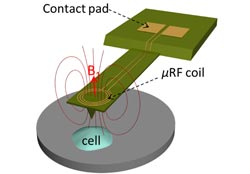New imaging technology could reveal cellular secrets

This image illustrates the concept for a new type of technology that combines two biological imaging methods - atomic force microscopy and nuclear magnetic resonance - to create a new way to study cancer-cell metastasis and other disease-related processes. (Purdue University image/ Xin Xu) <br>
“Let's say you have a large population of cells,” said Corey Neu, an assistant professor in Purdue University's Weldon School of Biomedical Engineering. “Just one of them might metastasize or proliferate, forming a cancerous tumor. We need to understand what it is that gives rise to that one bad cell.”
Such an advance makes it possible to simultaneously study the mechanical and biochemical behavior of cells, which could provide new insights into disease processes, said biomedical engineering postdoctoral fellow Charilaos “Harris” Mousoulis.
Being able to study a cell's internal workings in fine detail would likely yield insights into the physical and biochemical responses to its environment. The technology, which combines an atomic force microscope and nuclear magnetic resonance system, could help researchers study individual cancer cells, for example, to uncover mechanisms leading up to cancer metastasis for research and diagnostics.
The prototype's capabilities were demonstrated by taking nuclear magnetic resonance spectra of hydrogen atoms in water. Findings represent a proof of concept of the technology and are detailed in a research paper that appeared online April 11 in the journal Applied Physics Letters. The paper was co-authored by Mousoulis; research scientist Teimour Maleki; Babak Ziaie, a professor of electrical and computer engineering; and Neu.
“You could detect many different types of chemical elements, but in this case hydrogen is nice to detect because it's abundant,” Neu said. “You could detect carbon, nitrogen and other elements to get more detailed information about specific biochemistry inside a cell.”
An atomic force microscope (AFM) uses a tiny vibrating probe called a cantilever to yield information about materials and surfaces on the scale of nanometers, or billionths of a meter. Because the instrument enables scientists to “see” objects far smaller than possible using light microscopes, it could be ideal for studying molecules, cell membranes and other biological structures.
However, the AFM does not provide information about the biological and chemical properties of cells. So the researchers fabricated a metal microcoil on the AFM cantilever. An electrical current is passed though the coil, causing it to exchange electromagnetic radiation with protons in molecules within the cell and inducing another current in the coil, which is detected.
The Purdue researchers perform “mechanobiology” studies to learn how forces exerted on cells influence their behavior. In work focusing on osteoarthritis, their research includes the study of cartilage cells from the knee to learn how they interact with the complex matrix of structures and biochemistry between cells.
Future research might include studying cells in “microfluidic chambers” to test how they respond to specific drugs and environmental changes.
A U.S. patent application has been filed for the concept. The research has been funded by Purdue's Showalter Trust Fund and the National Institutes of Health.
Writer: Emil Venere, 765-494-4709, venere@purdue.edu
Sources: Corey Neu, 765-496-1426, cpneu@purdue.edu
Charilaos “Harris” Mousoulis, cmousoul@purdue.edu
Note to Journalists: Journalists can obtain a copy of the research paper by contacting Emil Venere, Purdue News Service, at 765-494-4709, venere@purdue.edu
Media Contact
More Information:
http://www.purdue.eduAll latest news from the category: Physics and Astronomy
This area deals with the fundamental laws and building blocks of nature and how they interact, the properties and the behavior of matter, and research into space and time and their structures.
innovations-report provides in-depth reports and articles on subjects such as astrophysics, laser technologies, nuclear, quantum, particle and solid-state physics, nanotechnologies, planetary research and findings (Mars, Venus) and developments related to the Hubble Telescope.
Newest articles

High-energy-density aqueous battery based on halogen multi-electron transfer
Traditional non-aqueous lithium-ion batteries have a high energy density, but their safety is compromised due to the flammable organic electrolytes they utilize. Aqueous batteries use water as the solvent for…

First-ever combined heart pump and pig kidney transplant
…gives new hope to patient with terminal illness. Surgeons at NYU Langone Health performed the first-ever combined mechanical heart pump and gene-edited pig kidney transplant surgery in a 54-year-old woman…

Biophysics: Testing how well biomarkers work
LMU researchers have developed a method to determine how reliably target proteins can be labeled using super-resolution fluorescence microscopy. Modern microscopy techniques make it possible to examine the inner workings…





















